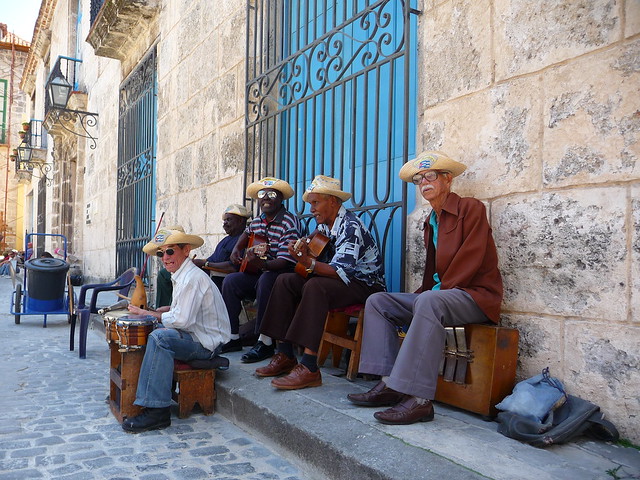Are Cubans Happy?
by Maraya Loza Koxahn
Our first day in Varadero, my partner and I stood on the sidewalk outside an outdoor café listening to lively Cuban rhythms. It was a muggy afternoon. Seven musicians squeezed into the alcove of the building situated on a corner of the main drag, and projected loudly onto the patio. The music spilled out into the street, attracting passersby. A woman strolled over from her hotel, beer in hand, on the way to the beach. She stopped to listen.
Since I was sharing the same general space as her, she commented in my direction in Spanish with a tone of surprise.
“Look at that—seven musicians, even a contra-bass, and all of them happy. It’s so unlike Argentina.”
Her foreign language just washed over me, not sticking, until she mentioned my beloved Argentina. I had lived in Buenos Aires and was passionate about Tango. I wanted to know more about what she thought, to engage her in a dialogue well beyond my limited Spanish skills. With bits of the two languages we had in common, we briefly contemplated together.
Why, we wondered, did music with the same black roots, evolving in two different countries but with the same language, within different (but both difficult) political situations, turn out so different? One style was simple and happy; the other, complex and melancholy. Both styles of music reflected their respective nation and its people. Maybe the threat of being “disappeared” was far greater in Argentina than in Cuba and the angst was expressed in Tango lyrics. Maybe the sun and rum of the Caribbean island makes one just want to gyrate on and on to monotonous Salsa rhythms.
The woman repeated over and over, as if awestruck, as if she couldn’t quite believe it, how happy they seemed … how happy … and then she headed to the beach.
Were they happy?
Candombe, Canyengue, Milonga, all the musical styles that were precursors to the Argentine Tango, expressed their black roots: lively, joyous, upbeat rhythms introduced by slaves. Mingling with other cultures, the music took a turn about a century ago and became “white-washed”. The more staid, and less life-positive, Tango survived. And, in the warmer island atmosphere of Cuba, Tango was introduced in the ‘20s but eventually fizzled out while the habanera rhythms lived on.
Music (and subsequently dance) is a creative expression of the heart and soul of people and their culture—whether happy or tortured. Although it makes one feel better to express in any form, those who create and express don’t always necessarily appear happy nor live a happy life. Music of any kind makes one feel better just by the making of it, the listening to it, and the dancing to it—even the Blues. Music is the universal language; music helps build community. These two Latin countries, even with all their strife, have had governments that understood the importance of supporting creative pursuits and making them available to their people—and the world. As an outsider, I feel privileged to have been able to partake in cultural events in both countries because of their governments’ sponsorship.
The fellows in the alcove looked like they were enjoying themselves. Later, they expressed much gratitude when my partner (a musician who supports and appreciates other musicians) generously tipped them. Two members of the group came over to introduce themselves and extend their thanks and wishes for our continued good health.
A couple days later, we made a short trip to Havana and I made a pilgrimage to the Casa del Tango. It shares a space with Salsa. We were greeted by a young woman from the Salsa side and, when I told her I was only interested in the Tango, she went back and sat down without a word. There were a handful of young people on the Salsa side chatting and dancing. The Tango side was filled with memorabilia from almost 100 years of history in the city, but had no music playing and no schedule of lessons or shows. I was so disappointed. Tango is danced all over the world … and this country let it slip away.
Back in the dining hall of our resort one evening, my partner called the serenading trio over and tipped them to play while he scrutinized a guitar, method and chording the likes of which he, in all his years of music, had never seen. The four became fast friends. The two guitarists didn’t seem particularly happy or unhappy, but the Afro-Cuban percussionist appeared quite unhappy, apparently suffering from sciatic pain.
There seems to be a belief (maybe it’s propaganda) that Cubans are happy people. I’m not so sure about that. Most of the Cubans that I came in contact with were in the tourism/service industry and dealing with impatient foreigners with attitudes of entitlement. I witnessed a lot of patience on the part of the locals, not so much happiness. Our tour guides, drivers and hosts seemed as pleasant as people you’d find anywhere else. But, I didn’t expect them to share—with me as a stranger—what was really going on for them. They had their public face on.
It doesn’t matter where we live, we all make our own happiness; it often has little to do with our external circumstances. Happiness is a choice, an individual characteristic, and a state of being. It’s not a “national” state of being.
I don’t think that Cubans, in general, are any happier (or unhappier) than people anywhere else in the world. I do believe that Cubans and Argentines (and I) are a lot happier when we’re surrounded by music and dance. Maybe musicians are happier than most because they have chosen to do something that they love. I feel a passionate affiliation with others when engaging in this shared activity. I believe this world would unite harmoniously if we would put aside our grievous differences, make music and dance.
Maraya Loza Koxahn lives in Calgary, Canada and likes to make frequent journeys so she has something to write home about. She plays with words and pixels and paint and music and thoughts—moving them around to create new configurations. She is currently writing a travel memoir called Love, Death & Tango. Maraya is also a freelance editor and creative writing teacher. You can find out more at www.TwoRedShoes.ca




